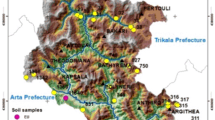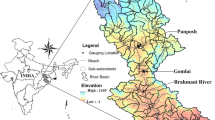Abstract
In this study, soil erosion was mapped in Ishmi-Erzeni watershed, Albania, using the G2 model. The G2 model has been proposed as an agri-environmental service by the Global Monitoring for Environment and Security (GMES) initiative (now Copernicus programme). Based on the principles of the Universal Soil Loss Equation (USLE), G2 provides maps of actual soil loss at a monthly time-step. The main innovations of the model with regard to previous USLE family models are as follows: the introduction of a ‘storm factor’, which differentiates rainfall erosivity (R factor) per month when detailed rain intensity records are not available; the use of standardised biophysical parameters derived from satellite image time series in combination with land use information for calculating the vegetation retention factor (denoted here as V factor, corresponding to C factor of USLE); and the use of satellite imagery for calculating a new factor, namely the slope intercept factor (denoted as I factor), which expresses landscape feature alterations, thus functioning as corrective to the topographic influence factor (denoted here as T factor, the slope length and steepness (LS) factor of USLE). The model was originally implemented in the cross-border Strymonas river basin and on the island of Crete after revision; in both cases with encouraging results. The G2 model follows a data-driven methodology, while providing alternatives for all factor estimations with moderate data requirements. For the model application in the Ishmi-Erzeni watershed (covering 2200 km2), rainfall data were collected from ten weather stations, and soil properties were measured from sampling at 47 locations. Vegetation layers were downloaded from the GMES portal, while land use information was extracted from a Landsat-7 TM image. Finally, terrain properties were calculated from a 250-m digital elevation model (DEM) of the area. The G2 model showed Ishmi-Erzeni to have moderate soil erosion, with a mean annual soil loss estimated to be 6.5 t/ha; however, 18 % of the area is facing an annual risk of soil removal more than 10 t/ha, which is considered to be a sustainable threshold for Albania. Winter months appear to be the most risky, with all months contributing substantially to the annual erosion rate (i.e. between 4 and 12 % each). Areas of coniferous and mixed forests, together with mountainous agricultural land, appear to be the most risky land uses. In conclusion, the G2 model proved to be useful and efficient for predicting erosion at monthly time-steps for all land uses in the Ishmi-Erzeni watershed. Future research will focus on an Albania-wide erosion mapping task, using the G2 model.











Similar content being viewed by others
References
Adlington, G. P. (2014). Albania—Land Administration and Management Project (LAMP): P096263—implementation status results report: sequence 15. Washington, DC: World Bank.
Baatz, M., Benz, U., Dehghani, S., Heynen, M., Hotlje, A., Hofmnn, P., Lingenfelder, I., Mimler, M., Sohlbach, M., Weber, M., and Willhauck, G. (2002). ECognition User’s Guide (Munich, Germany: Definiens Imaging GmbH), digital.
Banwart, S. (2011). Save our soils. Nature, 474, 151–152. doi:10.1038/474151a.
Baveye, P. C., Rangel, D., Jacobson, A. R., Laba, M., Darnault, C., Otten, W., Radulovich, R., & Camargo, F. (2011). From dust bowl to dust bowl: soils still a frontier of science. Madison: CSA News.
Borselli, L., Torri, D., Poesen, J., & Iaquinta, P. (2012). A robust algorithm for estimating soil erodibility in different climates. CATENA, 97, 85–94.
Burnett, C., & Blaschke, T. (2003). A multi-scale segmentation/object relationship modelling methodology for landscape analysis. Ecological Modelling, 168, 233–249.
Demiraj, E., Bicja, M., Gjik, E., Gjiknuri, L., Gjoka Mucaj, L., Hoxha, F., Hoxha, P., Karadumi, S., Kongoli, S., Mullaj, A., Mustaqi, V., Palluqi, A., Ruli, E., Selfo, M., Shehi, A., and Sino, Q. (1996). Implications of climate change for the Albanian Coast. MAP Technical Reports Series No.98, UNEP, Athens European Community. EIW Workshop: Elaboration of a Framework of a Code of Good Agricultural Practices, Brussels, pp. 21–22, May 1992.
Desmet, P., & Grovers, G. (1996). A GIS procedure for automatically calculating the USLE LS factor on topographically complex landscape units. Journal of Soil and Water Conservation, 51(5), 427–433.
Driesen, P. M. (1986). Erosion hazards and conservation needs as a function of land characteristics and land qualities. In W. Siderius (Ed.), Land evaluation for land-use planning and conservation in sloping areas (pp. 32–39). ILRI: The Netherlands.
Duran Zuazo, V. H., Aguilar Ruiz, J., Martinez Raya, A., & Franco Tarifa, D. (2005). Agriculture, Ecosystems and Environment, 107(2–3), 199–210.
Ferro, V., & Porto, P. (1999). A comparative study of rainfall erosivity estimation for southern Italy and southeastern Australia. Hydrological Sciences—Journal—des Sciences Hydrologiques, 44(1), 3–24.
Foster, G.R. and Meyer, L.D. (1972). A closed-form soil erosion equation for upland areas. In: H.W. Sten, ed. Sedimentation symposium in Honor Prof. H.A. Einstein. Fort Collins, CO: Colorado State University, 12.1_12.19.
Gavrilovic, Z. (1988). The use of an empirical method (erosion potential method) for calculating sediment production and transportation in unstudied or torrential streams. In: International conference of river regime, 18–20 May 1988, Wallingford. Chichester: John Wiley and Sons, 411–422.
Grazhdani, S., & Shumka, S. (2007). An approach to mapping soil erosion by water with application to Albania. Desalination, 213(1–3), 263–272.
Grimm, M., Jones, R. J. A., Rusco, E., & Montanarella, L. (2003). Soil erosion risk in Italy: a revised USLE approach. European Commission, EUR 20677 EN, (2002), p. 28. Luxembourg: Office for Official Publications of the European Communities.
Guyot, G., Baret, F., & Jacquemoud, S. (1992). Imaging spectroscopy for vegetation studies. In F. Toselli & J. Bodechtel (Eds.), Imaging spectroscopy: fundamentals and prospective applications (pp. 145–165). Dordtrecht: Kluwer Academic Publishing.
Jetten, V., de Roo, A., & Favis-Mortlock, D. (1999). Evaluation of field-scale and catchment-scale soil erosion models. Catena, 37(3–4), 521–541.
Karydas, C. G., Panagos, P., & Gitas, I. Z. (2014). A classification of water erosion models according to their geospatial characteristics. International Journal of Digital Earth, 7(3), 229–250.
Kinnel, P. I. A. (2003). Event erosivity factor and errors in erosion predictions by some empirical models. Australian Journal of Soil Research, 41(5), 991–1003.
Kirkby, M. J., Irvine, B. J., Jones, R. J. A., & Govers, G. (2008). The PESERA coarse scale erosion model for Europe. I.—model rationale and implementation. European Journal of Soil Science, 59(6), 1293–1306.
Laze, P. and Kovaci, V. (1996). Soil erosion and physico-chemical nature of eroded materials. 9th Conference of the International Soil Conservation Organization (ISCO), Bonn, Germany. Extended Abstracts.
Laze, P., Suljoti, V., Kovaci, P. and Brahushi, F. (2005). Thematic Assessment Report Land Degradation and Desertification. United Nations Convention to Combat Desertification. Tirana.
Marker, M., Angeli, L., Bottai, L., Costantini, R., Ferrari, R., Innocenti, L., & Siciliano, G. (2008). Assessment of land degradation susceptibility by scenario analysis: a case study in Southern Tuscany, Italy. Geomorphology, 93(1–2), 120–129.
Mitasova, H., Hofierka, J., Zlocha, M., & Iverson, R. (1996). Modelling topographic potential for erosion and deposition using GIS. International Journal of GIS, 10(5), 629–641.
Moore, I. D., & Burch, G. J. (1986). Physical basis of the length-slope factor in the universal soil loss equation. Soil Science Society America Journal, 50, 1294–1298.
Moore, I. D., & Wilson, J. P. (1992). Length-slope factors for the Revised Universal Soil Loss Equation: simplified method of estimation. Journal of Soil and Water Conservation, 4(5), 423–428.
Oldeman, L.R., Hakkeling, R.T.A., and Sombroek, W.G. (1991). World map of the status of human-induced soil degradation: an explanatory note. Wageningen: International Soil Reference and Information Centre; Nairobi: United Nations Environment Programme.
Panagos, P., Karydas, C. G., Gitas, I. Z., & Montanarella, L. (2012). Monthly soil erosion monitoring based on remotely sensed biophysical parameters: a case study in Strymonas river basin towards a functional pan-European service. International Journal of Digital Earth, 5(6), 461–487.
Panagos, P., Van Liedekerke, M., Jones, A., & Montanarella, L. (2012). European Soil Data Centre (ESDAC): response to European policy support and public data requirements. Land Use Policy, 29(2), 329–338.
Panagos, P., Meusburger, K., Alewell, C., & Montanarella, L. (2012). Soil erodibility estimation using LUCAS point survey data of Europe Environmental. Modelling and Software, 30, 143–145.
Panagos, P., Karydas, C., Ballabio, C., & Gitas, I. (2014). Seasonal monitoring of soil erosion at regional scale: an application of the G2 model in Crete focusing on agricultural land uses. International Journal of Applied Earth Observation and Geoinformation, 27(B), 147–155.
Panagos, P., Karydas, C. G., Borrellia, P., Ballabio, B., & Meusburger, K. (2014). Advances in soil erosion modelling through remote sensing data availability at European scale. Proceedings of SPIE, 9229, 92290I.
Renard, K. G., Foster, G. R., Weesies, G. A., McCool, D. K., & Yoder, D. C. (1997). Predicting soil erosion by water: a guide to conservation planning with the revised universal soil loss equation (RUSLE) (agricultural handbook 703) (p. 404). Washington, DC: US Department of Agriculture.
Richards, J. A., & Jia, X. (1999). Remote sensing digital image analysis. Heidelberg: Springer.
Rusi, M., Xhomo, A., and Rusi, S. (2006). Perdorimi i burimeve natyrore te reja per perfitimin e gurit gelqeror per nevojat e sektorit te ndertitmit dhe infrastruktures eshte domosdoshmeri dhe prioritet per ruajtjen e ambjentit. Qendra per kerkim dhe zhvillim (QKZH). Tirane, pp. 47–67.
Scherr, S.J. and Yadav, S. (1996). Land degradation in the developing world: implications for food, agriculture and the environment to 2020. Food, Agriculture, and the Environment Discussion Paper 14, Washington DC: International Food Policy Research Institute.
Van der Knijff, J. M., Jones, R. J. A., & Montanarella, L. (1999). Soil erosion risk assessment in Italy. European Soil Bureau. Italy: European Commission, JRC Scientific and Technical Report, EUR 19044 EN, p. 52.
Verhoef, W. (1985). Earth observation modeling based on layer scattering matrices. Remote Sensing of Environment, n., 17, 165–178.
Vrieling, A. (2006). Satellite remote sensing for water erosion assessment: a review. Catena, 65(1), 2–18.
Wischmeier, W.H. and Smith, D.D. (1978). Predicting rainfall erosion losses: a guide for conservation planning (Agriculture Handbook 537), US Department of Agriculture.
Yang, D., Kanae, S., Oki, T., Koike, T., & Musiake, K. (2003). Global potential soil erosion with reference to land use and climate changes. Hydrological Processes, 17, 2913–2928.
Zdruli, P. and Lushaj, Sh. (2012). Problems of soil degradation and alternative control measures for soil protection in Albania. Poster presentation, Book of Abstracts. EUROSOIL2012, Bari, Italy.
Zdruli, P., Lushaj, Sh., Pezzuto, A., Fanelli, D., D’Amico, O., Filomeno, O., De Santis, S., Todorovic, M., Nerilli, E., Dedaj, K., and Seferi, B. (2003). Preparing a georeferenced soil database for Albania at scale 1:250,000 using the European Soil Bureau Manual of Procedures 1.1. In: 7th International Meeting on Soils with Mediterranean Type of Climate, Selected Papers. OPTIONS méditerranéennes (Eds. Zdruli, Steduto and Kapur). Series A: Mediterranean Seminars No. 50. Bari, Italy. ISBN 2-85352-248-2.
Electronic sources
European Union (COM2012 46 final), http://ec.europa.eu/environment/soil/three_en.htm (last accessed: March 2015).
Copernicus programme, Global Land Service, http://land.copernicus.eu/global/products/FCover (last accessed: March 2015).
United States Geological Survey (USGS), 2011. Geographic Information System, http://glovis.usgs.gov/ (last accessed: March 2015).
WMO (World Meteorological Organization)(2007). Climate and Land Degradation Workshop, http://www.wmo.int/pages/prog/wcp/agm/meetings/wocald06/background_wocald06.php (last accessed: March 2015)
UNCCD (United Nations Convention to Combat Desertification), 2012. World Food Day 2012, Message of the UNCCD Secretary, UNCCD, Bonn, Germany, http://www.unccd.int/en/media-center/MediaNews/Pages/highlightdetail.aspx?HighlightID=133 (last accessed: March 2015).
European Space Agency (ESA), 2015; https://earth.esa.int/web/guest/missions/esa-operational-eo-missions/proba-v (last accessed: March 2015).
Acknowledgments
The authors wish to thank the Joint Research Centre, Institute for Environment and Sustainability, Land Resource Management Unit and especially Dr. Panos Panagos, for hosting the G2 model utilities and databases on the ESDB web portal (http://eusoils.jrc.ec.europa.eu/library/themes/erosion/G2/data.html). Also, we wish to thank the Mediterranean Agronomic Institute of Bari (IAMB) for supporting the soil sampling field survey and the Hydrometeorological Institute of Albania and the Tirana Meteorological Station for providing the weather data sets. Finally, we cordially thank Prof. Robert Jones, retired from Cranfield University, UK, for his diligent English review of the manuscript and to the anonymous reviewers, whose comments and suggestions improved the manuscript substantially.
Author information
Authors and Affiliations
Corresponding author
Rights and permissions
About this article
Cite this article
Karydas, C.G., Zdruli, P., Koci, S. et al. Monthly Time-Step Erosion Risk Monitoring of Ishmi-Erzeni Watershed, Albania, Using the G2 Model. Environ Model Assess 20, 657–672 (2015). https://doi.org/10.1007/s10666-015-9455-5
Received:
Accepted:
Published:
Issue Date:
DOI: https://doi.org/10.1007/s10666-015-9455-5




